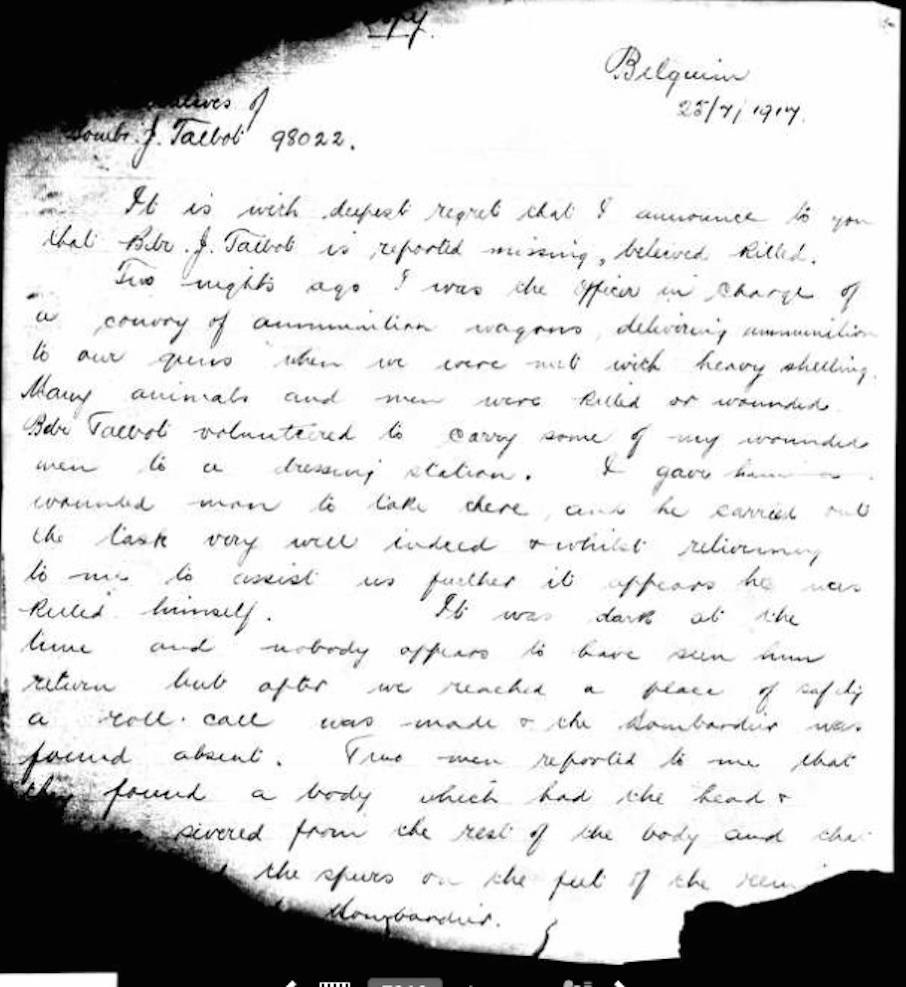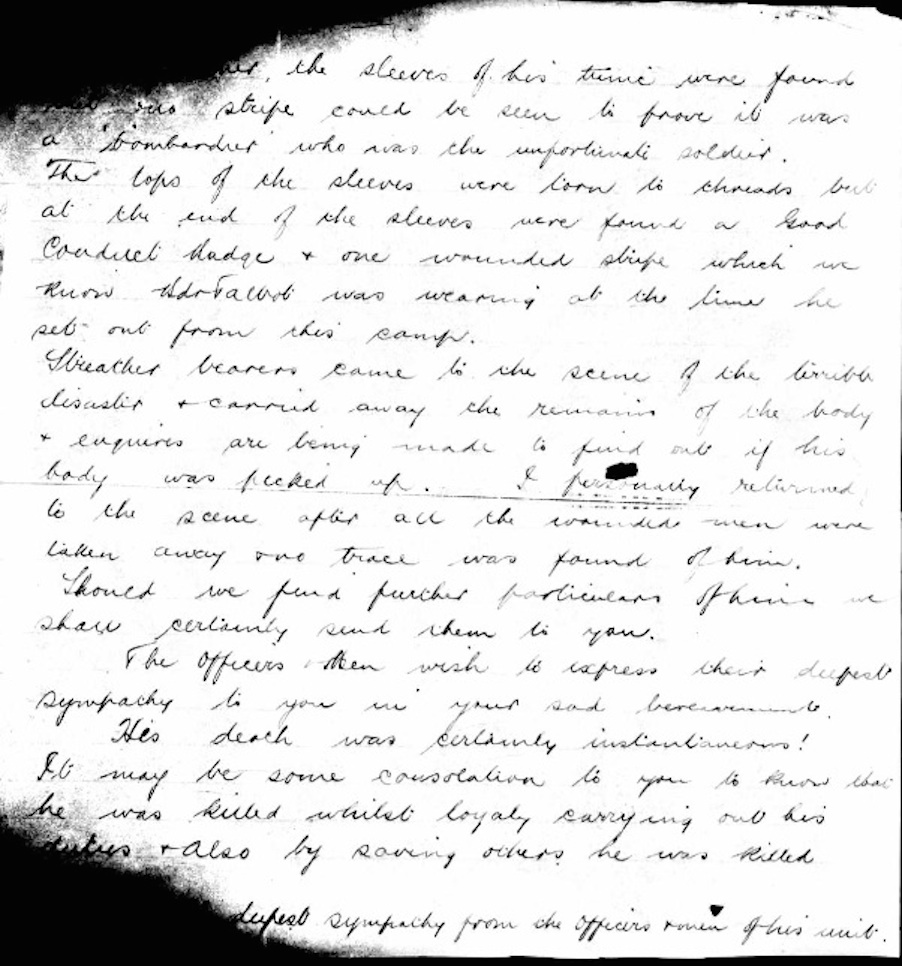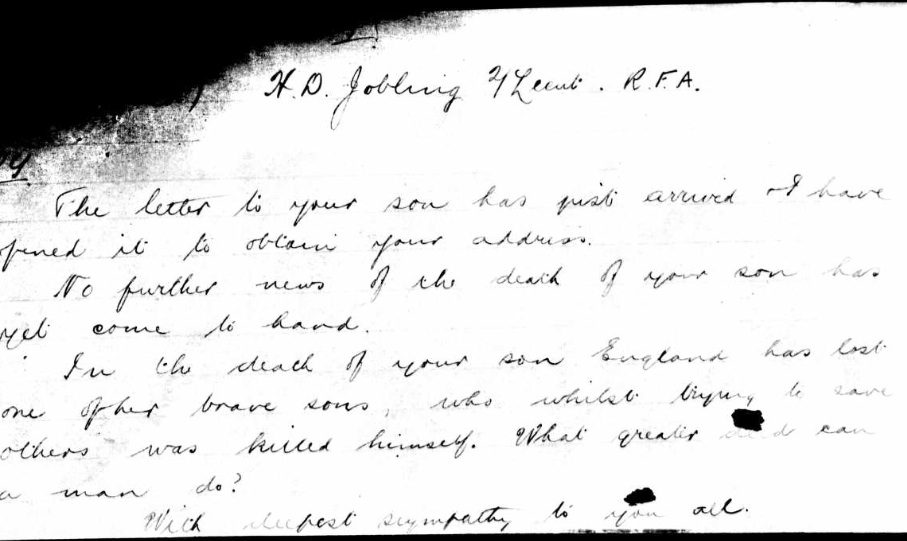Radcliffe on Trent WWI Letter
John Robert Talbot
John Robert Talbot was born in Caythorpe, Notts in 1897. When he attested in September 1914, by now living on Sydney Grove, Radcliffe on Trent, he claimed to be 18 years and 9 months. He was actually 16 years old. He entered France in May, 1915 and served with the Royal Field Artillery.
There is an extraordinary, graphic letter, dated 25.5.1917, filed in his service record which was sent to his parents from Belgium. A copy of the original is shown below. Written by 2nd Lt. H. D. Jobbling, it offers condolences for his death. John Talbot, now age nineteen, was in fact still alive. His service records state that he was wounded on 23.7.17. There is then a gap in his record until 17.4.18. when he is recorded as serving in Italy.
Letter from H. D. Jobbling regarding the ‘death’ of John Talbot
Belgium 25.7.1917……Relatives of
Bombr. J Talbot 98022
It is with deepest regret that I announce to you the Bdr J Talbot is reported missing, believe killed.
Two nights ago I was the officer in charge of a convoy of ammunition wagons delivering ammunition to our guns when we were met by heavy shelling.
Many animals and men were killed or wounded. Bdr Talbot volunteered to carry some of my wounded men to a dressing station. I gave him a wounded man to take there and he carried out the task very well indeed and whilst returning to me to assist us further it appears he was killed himself. It was dark at the time and nobody appears to have seen him return but after we reached a place of safety a roll-call was made and the bombardier was found absent. Two men reported to me that they found a body which had the head and…… severed from the rest of the body and the……the spurs on the feet of the………bombardier……..the sleeves of his tunic were found………stripe could be seen to prove it was a bombardier who was the unfortunate soldier.
The tops of the sleeves were torn to threads but at the end of the sleeves were found a Good Conduct Badge and one wounded stripe which we know Bdr Talbot was wearing at the time he set out from this camp.
Stretcher bearers came to the scene of this terrible disaster and carried away the remains of the body and enquiries are being made to find out if his body was picked up. I personally returned to the scene after all the wounded men were taken away and no trace was found of him. Should we find further particulars of him we shall certainly send them to you.
The officers and men wish to express their deepest sympathy to you in your sad bereavement.
His death was certainly instantaneous!
It may be of some consolation to you to know that he was killed whilst loyally carrying out his duties and also by saving others when he was killed.
Deepest sympathy from the officers and men of his unit
(Signed) H. D. Jobling 2/Lieut R F A
The letter to your son has just arrived and I have opened it to obtain your address. No further news of the death of your son has yet come to hand. In the death of your son England has lost one of her brave sons who whilst trying to save others was killed himself. What greater deed can a man do? With deepest sympathy to you all.
(Letter transcribed from John Talbot’s military records. See copy of original below)
It seems that John Talbot spent several months in hospital but it is not known if he was taken prisoner of war during this period of hospitalisation or if he escaped and was then treated in hospital.
A letter from his mother sent to the War Office and dated July 27 1919 hints at the possibility that he may have been captured and escaped. A torn fragment of the letter from her with much of the page missing remains in his service record. It reads:
In the issue of the Daily Mail May 8th – 19th and under the heading of rewards for escaped … in the field unconnected … capture and rendered … November 5th 1917. I beg to be … if the enclosed receive your kind attention. … my son who volunteered the 4th week of … and was wounded with … back on his second … France. … trusting if it has been unavoidably omitted that this letter for him may have your kind attention.Yours truly, Mrs. R. Talbot, Sydney Grove, Radcliffe on Trent
The reply to Mrs Talbot from the artillery record offices in Woolwich is a follows:
A note on his service record acknowledges that his mother has written re rewards for escapes in the Field.
Mrs. Talbot wrote again on August 27th 1919:
Sir, I beg to acknowledge the reply to my letter in respect of my son 98022 Bmdr. J. R. Talbot RFA who is at No 9 Rest Camp, Italian Ex. Force, Italy. … been there just over … months been sent out … hospital after 12 months … treatment from shock from the … copy I sent in my previous, his officer spoke so well of him in the letter he sent us, the original one may be had if perished trusting this will meet with your attention,
yrs truly, E. Talbot.
In 1918 (specific date not given) there is a request in his service record for ‘substantive rank held on admission to hospital for neurasthenia to be verified’. The request was granted.
John Talbot volunteered to stay on in the army of occupation in Italy until December 1919.
He then returned to Radcliffe on Trent and married Lily Elsie Emans in 1920. They had a son, John.
Click original letters above for larger image



